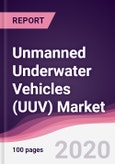Offshore oil and gas industry heavily depends on the vessels and container facilities provided by UUVs in deep waters for various exploration and upstream processes. Commercial Exploration in the ocean depths for oil, gas and minerals is a relatively recent activity. Since deep and ultra-deep oceans still remain to be an unexplored part of the planet, tremendous increase in the underwater activity can be foreseen in the near future.
The market size in 2017 was estimated to be $2.7 bn and it is expected to reach $4.7 bn by the year 2023. The CAGR for the unmanned underwater vehicles market for the period 2017- 2020 is estimated to be around 13%.
What are Unmanned Underwater Vehicles (UUV)?
UUV is a robot vehicle that can operate underwater without occupancy of human being. Unmanned underwater vehicles (UUV) are thus self-propelled vehicles. It is commonly used in industries and in military operations. These vehicles are designed to operate for periods ranging from a few hours to several days .The vehicles are equipped with the instruments and sensors whichever are required for the specific task they may be sonar, camera, explosive devices, chemical injector and various others. They are preferred for subsea applications because they are continuously assisted by high end computer systems and offer safe option for activities and exploration underwater.
What are the major applications for Unmanned Underwater Vehicles (UUV)?
UUVs have gained popularity with the growing technical features and the continuously evolving specialized mounting equipment. The applications include surveillance, reconnaissance, mine countermeasures, ocean floor mapping, pipeline inspection, polar ice research, anti-submarine warfare and so on. The subsea explorers and extraction companies are the major users for the equipment along with military and naval forces. It assists in the subsea activities which otherwise are to be performed by human themselves. Hence they help in maintaining secure method for underwater functions of various companies which have to deal with them.
Unmanned Underwater Vehicles Market
Market Research and Market Trends of Unmanned Underwater Vehicles (UUV) Ecosystem
To improve the ability of unmanned systems to communicate and operate between air, surface, and undersea domains is one important area of focus beyond developing larger UUVs. In a manner similar to manned ships and helicopters currently collaborating to locate and destroy sea mines, unmanned surface and undersea vehicles could be used to accomplish the same mission while keeping human operators at safe end. AeroVironment successfully achieved communication of its Blackwing UAV with a swarm of unmanned undersea vehicles recently and parallel to it Lockheed Martin also launched a UAV from a Marlin MK2 autonomous underwater vehicle successfully.
The Navy and other DoD departments have allocated considerably more funds for the next generation UUV systems and technologies research. Defense funding for research into UUVs is around three times more than funds for procurement. The Large Displacement Unmanned Undersea Vehicle (LDUUV) and the Extra Large UUV (XLUUV) are the largest portions of these research programs.
Hydronalix recently received a contract for an advanced research to for development of prototype mobile gateway buoys with integrated communications and control software from the Naval Air Warfare Center Aircraft Division. Hydronalix engineers are building an improved gateway buoy hull with hybrid electric and heavy-fuel propulsion, which integrates MK 18 gateway buoy communications equipment, and controlled by Neptune control software. The company will build two gateway buoy prototypes, and integrate them with control software and acoustic communication systems.
Ability of USVs and UUVs systems to adapt intelligently to changes in their tactical situations is another important feature which is of prime importance. Improvements in the autonomous capabilities of these systems are crucial to their future development. There are changes expected in the tactical situations as the specific missions of these vehicles evolve and their onboard sensing systems will also continuously evolve indicating such changes. The onboard systems must be capable of recognizing the changes and adapting the mission plan accordingly, without the need for intervention by operators. Hence AI and ML concepts are being considered for OBEs.
Who are the Major Players in Unmanned Underwater Vehicles (UUV) market?
The players profiled in the report include SAAB Seaeye, Oceaneering International Inc., Subsea7, Deep Ocean Engineering, FMC Schilling Robotics LLC, Bluefin Corp, Atlas Elektronik , BAE Systems, BaltRobotics Sp.z.o.o., Boston Engineering Corporation
What is our report scope?
The report incorporates in-depth assessment of the competitive landscape, product market sizing, product benchmarking, market trends, product developments, financial analysis, strategic analysis and so on to gauge the impact forces and potential opportunities of the market. Apart from this the report also includes a study of major developments in the market such as product launches, agreements, acquisitions, collaborations, mergers and so on to comprehend the prevailing market dynamics at present and its impact during the forecast period 2018-2025.
Key Takeaways from this Report
Evaluate market potential through analyzing growth rates (CAGR %), Volume (Units) and Value ($M) data given at country level – for product types, end use applications and by different industry verticals.
Understand the different dynamics influencing the market – key driving factors, challenges and hidden opportunities.
Get in-depth insights on your competitor performance – market shares, strategies, financial benchmarking, product benchmarking, SWOT and more.
Analyze the sales and distribution channels across key geographies to improve top-line revenues.
Understand the industry supply chain with a deep-dive on the value augmentation at each step, in order to optimize value and bring efficiencies in your processes.
Get a quick outlook on the market entropy – M&A’s, deals, partnerships, product launches of all key players for the past 4 years.
Evaluate the supply-demand gaps, import-export statistics and regulatory landscape for more than top 20 countries globally for the market.
Table of Contents
Methodology

LOADING...








